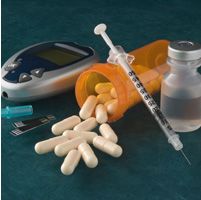Article
Antihyperglycemic Agents Often Stopped After Hospitalization
Author(s):
Study results suggest that antihyperglycemic agents are too often inappropriately discontinued after hospitalization for type 2 diabetes mellitus, possibly to the detriment of patients.

A study in Diabetes Therapy suggests that antihyperglycemic agents (AHAs) are too often inappropriately discontinued after hospitalization for type 2 diabetes mellitus (T2DM), possibly to the detriment of patients.
The finding is important given that the US prevalence of diabetes is nearing 10%, and that number of hospitalizations rises each year, to 5.5 million in 2009. “Previous research has suggested that discontinuity of care from the inpatient to the outpatient setting is common, with perhaps as many of 42% of patients discharged on medication not reporting that medication regimen to subsequent outpatient providers,” the study authors noted.
Current treatment guidelines recommend the use of insulin as the preferred treatment for hyperglycemia in the hospital setting, and as a result, hospitalized patients with T2DM often have the other AHAs held and insulin initiated. But how do those patients transition to outpatient care?
The current study, funded by Janssen Pharmaceuticals, looked at AHA utilization among a sample of United States adults with a T2DM diagnosis listed on an inpatient admission during 2010—2012 in the MarketScan Hospital Drug database (Truven Health Analytics). AHA use while hospitalized was measured from inpatient medication administration records in that database. AHA use pre- and post-hospitalization was assessed from outpatient retail and mail order pharmacy claims in the MarketScan Commercial and Medicare Supplemental databases, which contain de-identified insurance claims from large employers and health plans. The hospital and claims databases are linked, allowing patients to be followed across transitions of care.
The study sample (N = 8144) was 53% male, with a mean age of 66 years. Twenty-one percent had no T2DM diagnosis or claims for AHAs in the 90-day pre-hospitalization period, suggesting they may have been newly diagnosed at the time of admission. Most (83%) patients used AHAs while hospitalized, but the proportions with AHA claims 30 days pre- and post-hospitalization were only 53% and 40%, respectively. Biguanides and sulfonylureas were the most common outpatient agents. Most (70%) patients who had no AHA utilization pre-hospitalization continued to have no AHA utilization post-hospitalization. About half the patients with AHA claims pre-hospitalization did not have any AHA claims post-discharge.
“This is concerning because lack of continuity of care has been associated with adverse clinical outcomes, especially in patients with a chronic condition,” the authors observed. “In a study of Medicare beneficiaries with diabetes hospitalized for acute myocardial infarction, for example, patients discharged without AHA therapy had higher mortality rates 30 days, 6 months, and 1 year post-hospitalization than patients discharged on AHA therapy, even after multivariable adjustment of differences between groups.”
The authors suggest that this lack of treatment modification or follow-up care despite evidence of poorly controlled disease may reflect “clinical inertia, or, alternatively, a deliberate decision to not utilize AHAs post-hospitalization. “This may be problematic, as patients with T2DM who are hospitalized tend to have poorer glycemic control than comparable patients who are not hospitalized, and the hospitalization may present an opportunity to intervene,” the researchers concluded.




